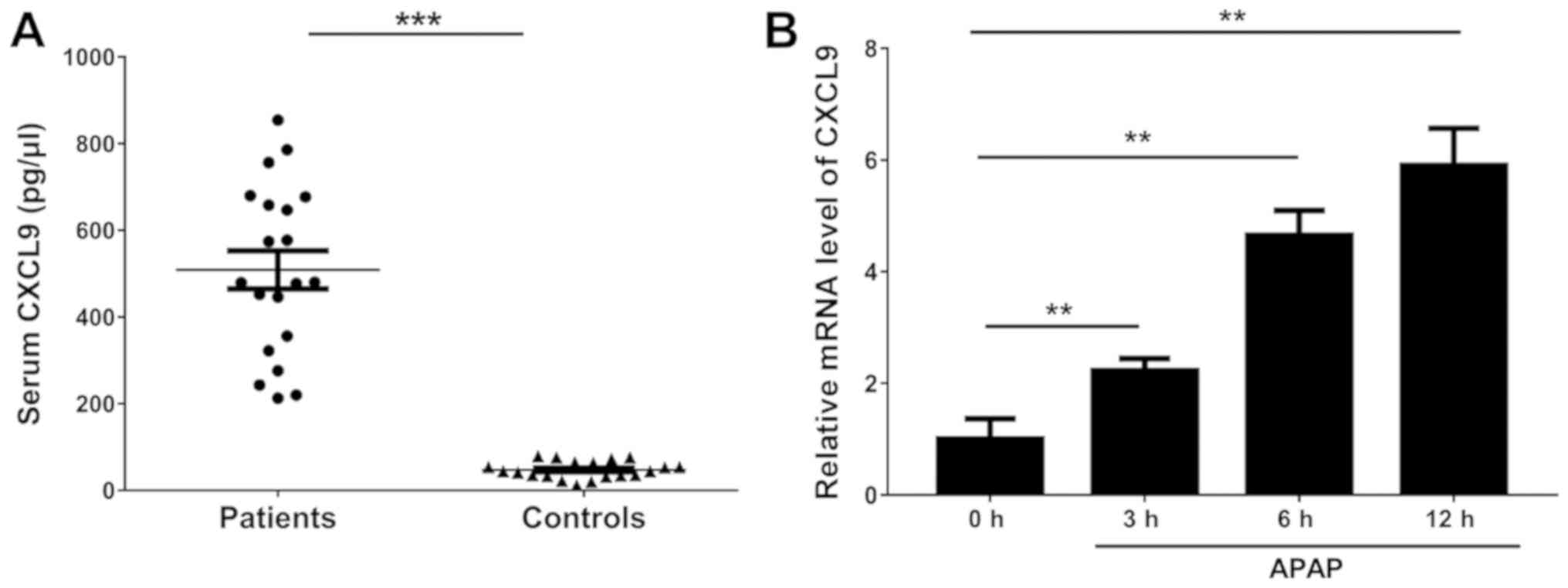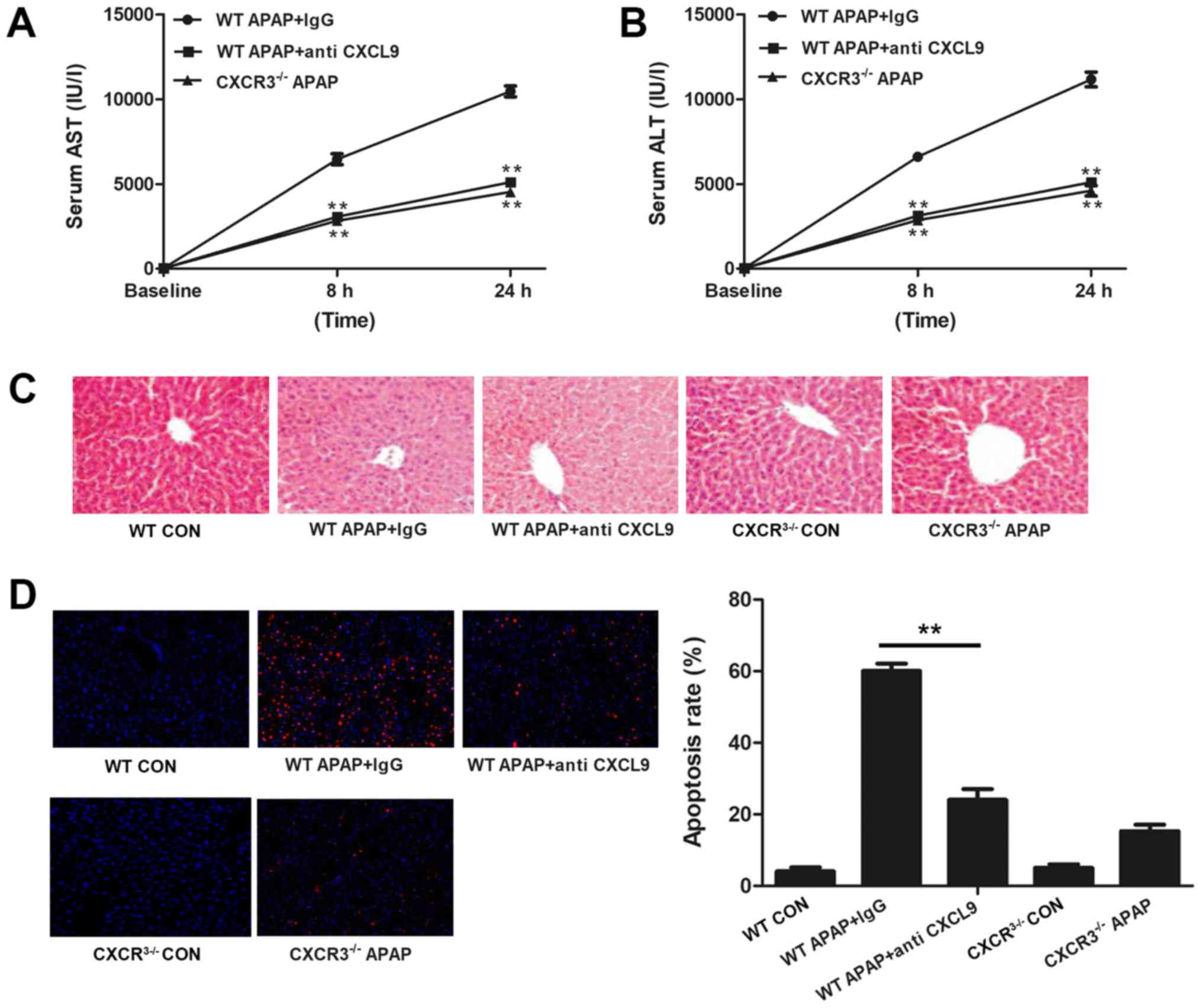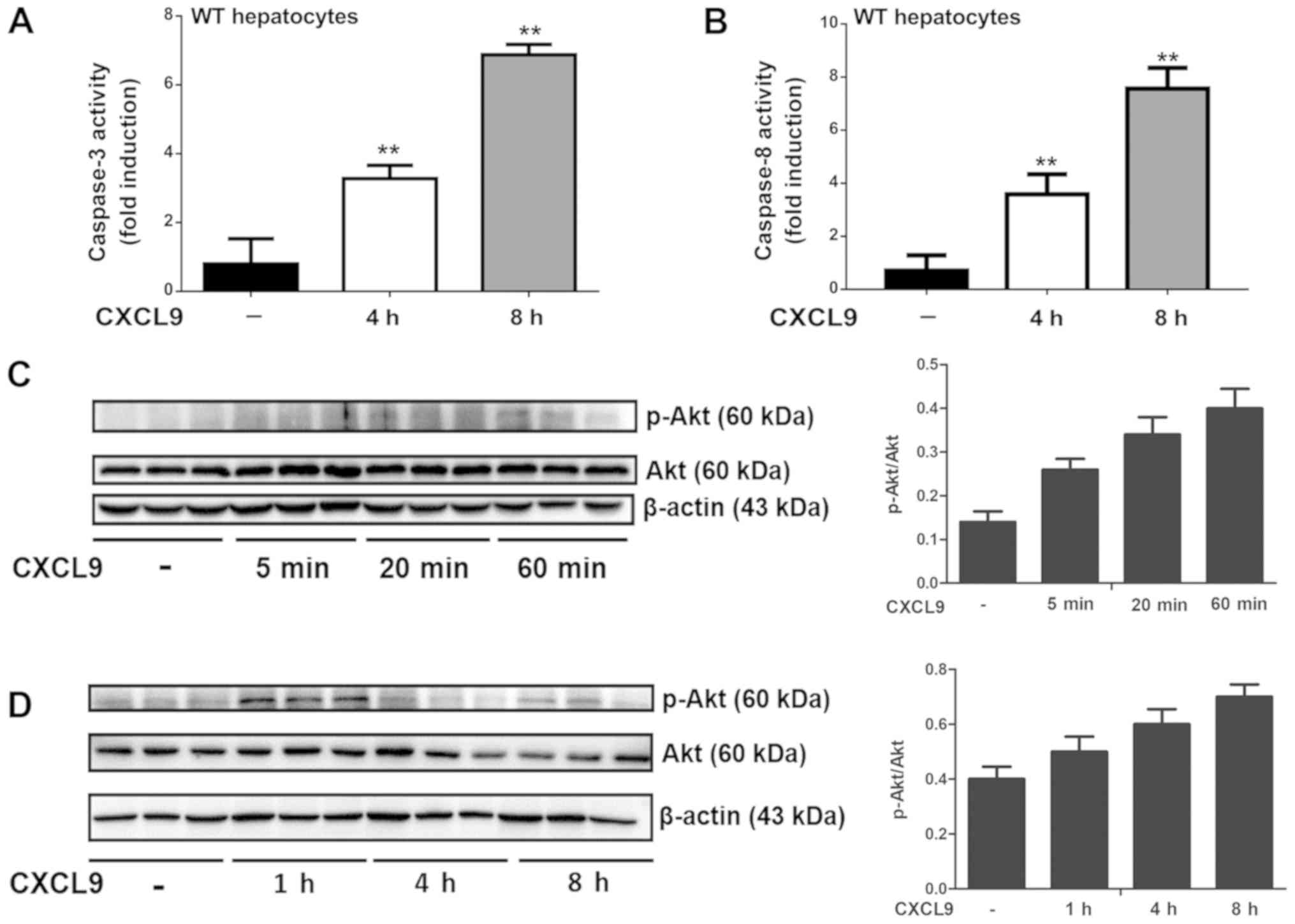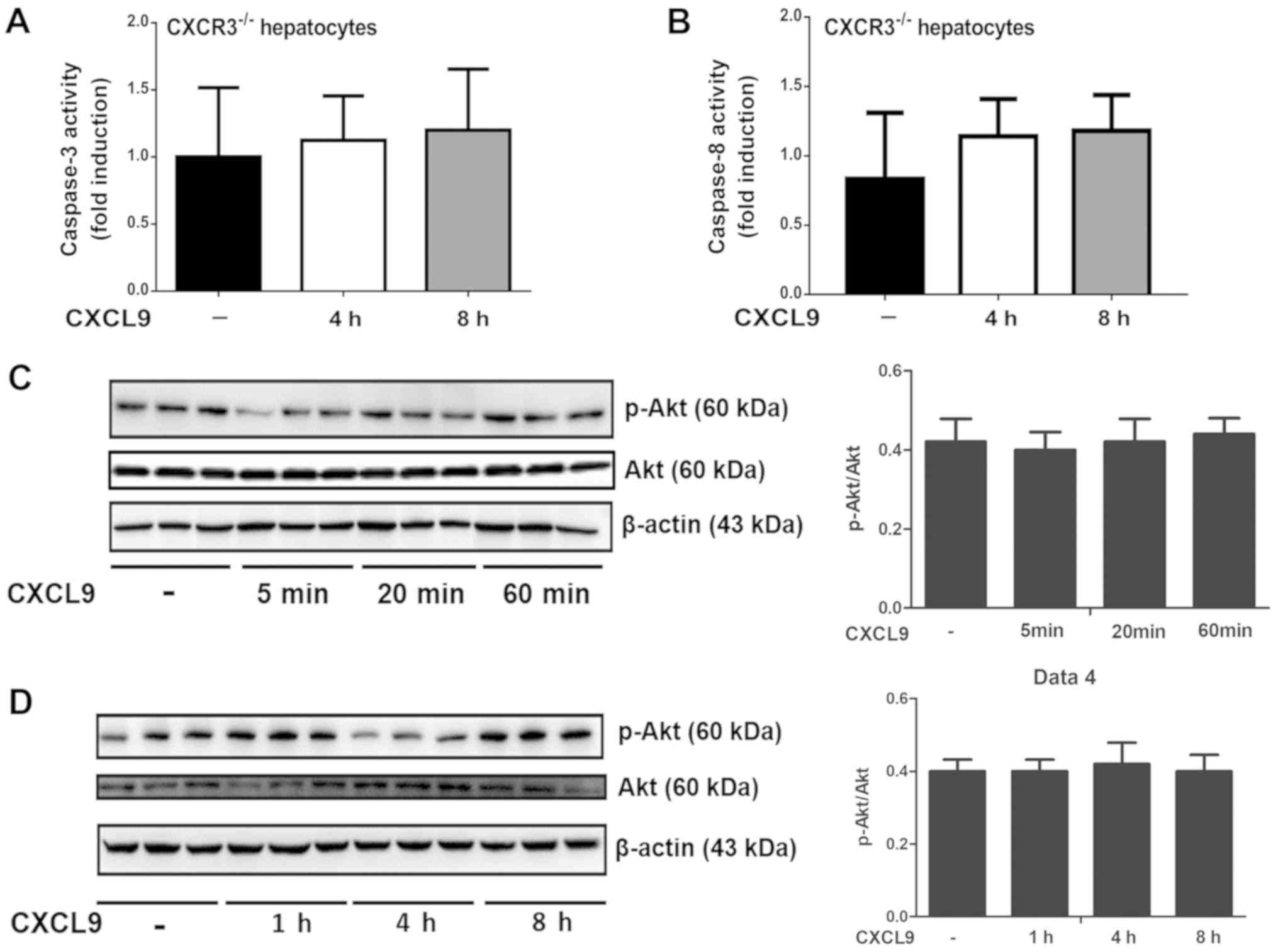Introduction
Drug-induced liver injury (DILI) is a common side
effect of drug administration and is also one of the leading causes
of acute liver failure and liver transplantation in Western
countries (1). DILI has a
significant role in failure of numerous new drug developments and
withdrawals from the market (2,3).
Acetaminophen (APAP) is an acetanilide antipyretic
analgesic, which is frequently utilized as an over-the-counter drug
due to its safety and reliability. APAP has been used as an adjunct
therapy for acute and chronic hepatitis in China for several
decades (4). However, APAP overdose
is one of the leading causes of DILI globally accounting for
>50% of cases (5). It has proven
difficult to elucidate the specific pathogenesis of DILI due to the
differing severity of symptoms between patients resulting from
individual differences (6).
A small amount of APAP in the liver produces
biologically active N-acetyl-p-benzoquinone imine (NAPQI), which is
detoxified via binding to glutathione (GSH). APAP overdose results
in NAPQI accumulation in the liver, thereby over-consuming GSH
(7). GSH deficiency inhibits the
function of peroxide inactivation leading to further accumulation
in the body (8). It is reported that
the subsequent inflammatory response cascade serves an essential
role in DILI (9). Among multiple
pathological changes in DILI, hepatocyte apoptosis is considered to
be the leading cause of APAP-induced liver injury (10,11).
Therefore, investigation into the pathogenesis of APAP-induced
liver injury is of great significance to improve clinical outcomes
of affected patients.
Chemokines are capable of inducing immune cell
migration to inflammatory lesions and they directly affect the
function of intrinsic cells (12).
C-X-C motif chemokine receptor 3 (CXCR3) and its ligands, C-X-C
motif chemokine ligand (CXCL)-9, CXCL10 and CXCL11 have been
reported to be involved in various pathological processes, such as
tumor development, immunity and inflammation (13,14).
Chemokines are difficult to detect in non-lymphoid tissues under
physiological conditions, however they are released at high levels
during inflammation, infection or injury (15). CXCL9 and its receptors have been
widely reported to regulate tumor invasion, metastasis, leukocyte
invasion and T cell activation (16). The specific role of CXCL9 in cell
apoptosis remains unclear. In the present study, it was
hypothesized that CXCL9 could promote hepatocyte apoptosis via
binding to CXCR3, thereby aggravating APAP-induced liver
injury.
Materials and methods
Subjects
A total of 20 healthy men aged 24–66 (37.2±12.0)
ingested APAP (500 mg) after fasting for 24 h; as a control a
further 20 healthy male volunteers, aged 18–63 (37.8±10.7), who had
fasted for 24 but not ingested APAP were enrolled in this study. 5
ml of blood was acquired from the peripheral vein of each patient
and the blood samples were then centrifuged at 2,500 × g at 4°C for
5 min to obtain serum. None of the subjects had suffered from viral
hepatitis or other autoimmune diseases, and there was no
statistically significant difference in ages between the two
groups.
Experimental animals
CXCR3−/− mice used in the present study
were obtained from the Jackson Laboratory (Bar Harbor, ME, USA). A
total of 100 8 week-old male wild type (WT) mice and 50
CXCR3−/− mice weighing between 18–22 g, were used for
experiments, with 6–8 mice in each group. All mice were housed
individually in a specific pathogen-free level animal experimental
center with free access to water and food.
Animal model construction
The 8 week-old male WT and CXCR3−/− mice
were intraperitoneally injected with 250 mg/kg APAP (5). Immediately after this, the experimental
group mice were further injected with 100 µg (in 100 µl volume)
CXCL9 neutralizing antibody (cat no 50155-R277; Sino Biological
Inc., Beijing, China) or 5 µg (in 100 µl volume) recombinant CXCL9
(cat no 50155-MNAE; Sino Biological Inc.). Mice in the control
group were injected with an equivalent dose of control IgG or
saline. A total of 0.1 ml blood was collected from the tail vein of
each mouse before the mice were sacrificed using 5% isoflurane
followed by cervical dislocation. Mice were sacrificed and liver
tissues were harvested after 8 (n=3) or 24 (n=3) h. Blood samples
were centrifuged at 4,500 × g at 4°C for 5 min to obtain serum.
Biochemical and pathological
analyses
Serum samples from APAP-treated WT and
CXCR3−/− mice were collected for the analysis of alanine
aminotransferase (ALT) and aspartate aminotransferase (AST) levels.
Biochemical analyzer (model AU480; Beckman Coulter, Inc.) was used
for ALT and AST colorimetric detection. Caspase-3 expression in
liver tissues was determined using a caspase-3 detection kit
(Beyotime Institute of Biotechnology; cat. no. C1168S) according to
the instructions of the manufacturer.
Transferase-mediated deoxyuridine
triphosphate-biotin nick end labeling (TUNEL) staining
Mice were sacrificed, then livers were dissected.
After overnight incubation in 4% paraformaldehyde, livers were
dehydrated and embedded in paraffin. Sections of 5 µm thickness
were cut and mounted on poly-lysine-coated slides, and hepatocyte
apoptosis was detected using a TUNEL assay (Beyotime Institute of
Biotechnology) according to the instructions of the
manufacturer.
Hematoxylin and eosin (H&E)
staining
Mice were sacrificed and their livers were
dissected. After overnight incubation at room temperature in 4%
paraformaldehyde, livers were dehydrated and embedded in paraffin.
Sections of 5 µm thickness were cut and mounted on
poly-lysine-coated slides (10 slides per tissue). After H&E
staining (hematoxylin, 5 min at room temperature and eosin, 3 min
at 20°C) sections were observed (5 views per slide) with a light
microscope (magnification ×400).
Reverse transcription-quantitative
polymerase chain reaction (RT-qPCR)
Total RNA was extracted from cells using the
TRIzol® method (Invitrogen; Thermo Fisher Scientific,
Inc., Waltham, MA, USA) then quantified. cDNA was synthesized using
the Prime Script™ RT-PCR Kit (Takara Bio, Inc., Otsu, Japan)
according to the instructions of the manufacturer. A total of 2 µl
cDNA was used for each reaction, amplified by real-time PCR using
SYBR® Premix Ex Taq™ II (Takara Bio, Inc.). Relative
mRNA expression was analyzed by qPCR using the IQ™ 5 System
(Bio-Rad Laboratories, Inc., Hercules, CA, USA). Primers were
synthesized by Shanghai ShengGong Co., Ltd. (Shanghai, China).
Primer sequences were as follows: CXCL9, forward
5′-CCTAGTGATAAGGAATGCACGATG-3′ and reverse
5′-CTAGGCAGGTTTGATCTCCGTTC-3′; and GAPDH, forward
5′-TGAAGGTCGGAGTCAACGGATT-3′ and reverse
5′-CCTGGAAGATGGTGATGGGATT-3′. The 2−∆∆Cq method was used
to calculate the relative mRNA expression (17). The thermocycling conditions were as
follows: Initial denaturation at 95°C for 5 min, followed by 40
cycles of 95°C for 30 sec, 95°C for 5 sec and 60°C for 31 sec,
before a final extension at 94°C for 15 sec. Each experiment was
repeated in triplicate.
Western blot analysis
Cells were lysed with RIPA buffer (Beyotime
Institute of Biotechnology) containing protease inhibitors. Protein
concentration was quantified using bicinchoninic acid protein assay
(Pierce; Thermo Fisher Scientific, Inc.). Protein samples (10 µg)
were separated on 12% SDS-PAGE gel and transferred to
polyvinylidene fluoride membranes (Roche, Basel, Switzerland).
Membranes were incubated in 5% non-fat milk at 25°C for 1 h to
block non-specific binding. Membranes were then membranes incubated
overnight at 4°C with primary antibodies targeting phosphorylated
(p-) Akt (cat. no. ab81283; 1:500; Abcam, Cambridge, MA, USA),
total Akt (cat. no. ab18785; 1:500; Abcam), and β-actin (cat. no.
ab8226; 1:500; Abcam). Membranes were washed three times with PBS,
then samples were incubated with anti-rabbit or anti-mouse
secondary antibodies purchased from Beyotime Institute of
Biotechnology (cat. no. A0208/A0216; 1:1,000). Bands were
visualized using enhanced chemiluminescence substrate (Thermo
Fisher Scientific Inc.). Quantity One (version 4.0; Bio-Rad
Laboratories, Inc.) was used for densitometric analysis.
ELISA
Human serum samples were collected and CXCL9 levels
were determined, in accordance with ELISA kit instructions (cat.
no. ab119588; Abcam). The absorbance of each sample was detected at
wavelengths 562 and 450 nm.
Isolation and culture of primary
hepatocytes
Isolation and culture of primary hepatocytes were
performed as previously described (18). In brief, WT and CXCR3−/−
mice were sacrificed for access to the liver. Liver tissues were
digested with digestive buffer containing collagenase, ground, and
then filtered for preparation of single cell suspension. After
gradient centrifugation and lysis with red blood cell lysis buffer,
mouse primary hepatocytes were obtained. Cells were cultured in
William's E medium (Gibco; Thermo Fisher Scientific, Inc.) for 14
h, serum-starved for 3 h, and then treated with 100 ng/ml CXCL9.
Protein samples were collected at 5 min, 20 min, 1, 4 or 8 h
post-treatment.
Statistical analysis
Graphpad Prism (v6.0) software (GraphPad Software,
Inc., La Jolla, CA, USA) was used for statistical analysis. Data
are presented as the mean ± the standard deviation. Differences
amongst groups were compared using one-way analysis of variance,
followed by Bonferroni correction. P<0.05 was considered to
indicate significant difference.
Results
CXCL9 participates in the pathological
process of APAP-induced liver injury
Serum levels of CXCL9 were determined in 20 male
patients who took APAP tablets in a fasting state and in 20 fasted
male controls. The results demonstrated that serum levels of CXCL9
were significantly higher in patients who took APAP compared with
the control group (Fig. 1A).
For the animal experiments, male WT mice were
randomly assigned into one of two groups, receiving either
intraperitoneal injection of APAP or PBS. The mRNA levels of CXCL9
in liver tissues were detected at 1, 3, 6 and 12 h following
injection. Compared with mice injected with PBS, those injected
with APAP presented significantly increased mRNA levels of CXCL9,
even up to 12 h post-injection (Fig.
1B).
Neutralization of CXCL9 attenuates
APAP-induced liver injury
Following intraperitoneal injection of APAP, WT mice
received intraperitoneal injection of anti-CXCL9 neutralizing
antibody or control immunoglobulin (IgG). Serum and liver samples
were collected after 8 and 24 h. Serum levels of ALT and AST were
lower in mice injected with anti-CXCL9 neutralizing antibody and
CXCR3−/− mice, compared with the control group of WT
mice that received APAP and IgG only (Fig. 2A and B). There were no significant
differences in ALT and AST levels between mice injected with
anti-CXCL9 neutralizing antibody and CXCR3−/− mice.
(Fig. 2A and B). HE staining
revealed that neutralization of CXCL9 attenuated APAP-induced liver
injury and knockout of CXCR3 also alleviated APAP-induced liver
injury (Fig. 2C). TUNEL assay
indicated that hepatocyte apoptosis was alleviated in liver tissues
from the anti-CXCL9 neutralizing antibody group and the
CXCR3−/− group (Fig. 2D).
These results suggested that neutralization of CXCL9 or knockout of
CXCR3 attenuated APAP-induced liver injury.
CXCL9 promotes hepatocyte apoptosis
via the AKT pathway
To further explore the specific mechanism of CXCL9
in APAP-induced liver injury, primary hepatocytes were isolated
from WT mice for subsequent experiments. Primary hepatocytes were
treated with or without recombinant CXCL9 for different time
periods. Activities of caspase-3 and caspase-8 in hepatocytes were
significantly elevated following CXCL9 treatment for 4 and 8 h
(Fig. 3A and B). The AKT pathway was
activated within the first 5 min of CXCL9 treatment in a
time-dependent manner, and the activation lasted for up to 8 h
(Fig. 3C and D).
CXCL9 induces hepatocyte apoptosis via
binding to CXCR3
Studies have demonstrated that CXCL9 is involved in
tumor metastasis and the inflammatory response via binding to the
CXCR3 receptor. Hence, it was hypothesized that CXCL9 regulates
hepatocyte apoptosis through CXCR3 in APAP-induced liver injury.
Primary hepatocytes from CXCR3−/− mice were treated with
recombinant CXCL9 or vehicle control. Activities of caspase-3 and
caspase-8 were measured by fluorescence spectrophotometry. There
was no significant difference in expression of caspase-3 and
caspase-8 after CXCL9 stimulation for 4 and 8 h (Fig. 4A and B). In addition, there was no
significant difference in p-AKT (S437) expression for up to 8 h
following CXCL9 treatment, compared with control untreated
CXCR3−/− hepatocytes (Fig. 4C
and D). The present data demonstrated that CXCL9 exerted its
function in APAP-induced liver injury via binding to CXCR3.
CXCL9 induces CXCR3-mediated apoptosis
in mouse liver
Mouse experiments were further performed to confirm
the roles of CXCL9 and CXCR3 in APAP-induced hepatocyte apoptosis
in vivo. Intraperitoneal injections of CXCL9 were
administered to both WT and CXCR3−/− mice. At 24 h
following CXCL9 administration, the caspase-3 activity in the liver
tissues of WT mice was significantly higher compared with
CXCR3−/− mice (Fig. 5A).
In addition, serum levels of ALT and AST were also significantly
higher in WT mice compared with CXCR3−/− mice, following
24 h of CXCL9 administration (Fig. 5B
and C).
Discussion
The present study, demonstrated that APAP
administration resulted in increased secretion of CXCL9, thereby
stimulating hepatocyte apoptosis and leading to liver damage
through binding to CXCR3 and via the AKT pathway.
Three major steps are involved in APAP-induced liver
injury. Firstly, APAP and its metabolites directly lead to the
hepatocyte stress response (intrinsic pathway), activation of the
immune response (extrinsic pathway) and mitochondrial dysfunction.
Secondly, mitochondrial permeability transition pores (MPTs) open.
Finally, MPT opening leads to apoptosis and necrosis of liver cells
(19). It had been previously
reported that cytokines are involved in the pathogenesis of various
liver diseases, particularly in immune diseases induced by
inflammation and T cells (12,20).
The present results suggested that administration of
a neutralizing CXCL9 antibody significantly reduced APAP-induced
liver injury in WT mice. Hepatocyte apoptosis was increased after
CXCL9-treatment in primary hepatocytes. CXCR3 is the common
receptor of CXCL9 and has been well studied for many diseases
(15,16). The present data confirmed that
interaction between CXCL9 and CXCR3 is involved in hepatocyte
apoptosis induced by APAP. CXCR3 deficiency did not induce
apoptosis of mouse hepatocytes both in vitro and in
vivo.
The downstream mechanism of CXCL9 binding to CXCR3
has not been clearly elucidated. The present study detected
expression of apoptosis and transcription-related signaling
pathways following CXCL9 stimulation. Surprisingly, AKT was
phosphorylated after APAP induction indicating that CXCL9 regulates
APAP-induced liver injury via the AKT pathway.
Inflammatory factors and macrophages are considered
to be associated with APAP-induced liver injury (21–24). The
present study hypothesized that hepatocyte apoptosis was the most
important factor for APAP-induced liver injury and subsequent
progression to liver cirrhosis which is consistent with previous
studies (10–12). Strict control of hepatocyte apoptosis
contributes to inhibition of inflammatory factors in necrotic
tissues.
It is of great significance to understand the
pathogenesis of DILI in order to prevent and treat clinical DILI.
It has been suggested that DILI is regulated by various aspects,
such as drug metabolism, mitochondrial function impairment, immune
response, signal transduction, genetic and environmental factors.
The present study determined that CXCL9 and CXCR3 exerted key roles
in hepatocyte apoptosis induced by APAP. Taken together, these
findings suggest that CXCL9 may be a potential therapeutic
intervention target for acute hepatitis and liver failure, and
could provide a novel prevention and treatment strategy for
DILI.
Acknowledgements
Not applicable.
Funding
No funding was received.
Availability of data and materials
All data generated or analyzed during this study are
included in this published article.
Authors' contributions
XS and HW designed the study and performed the
experiments, YS, YL and ZT established the animal models, YS, JZ
and JW collected the data, XS and YS analyzed the data, XS and HW
prepared the manuscript. All authors read and approved the final
manuscript.
Ethics approval and consent to
participate
This study was approved by the Animal Ethics
Committee of Nanjing Medical University Animal Center, and was
approved by the ethics committee of Nanjing First Hospital. Signed
written informed consents were obtained from the patients and/or
their guardians.
Patient consent for publication
Not applicable.
Competing interests
The authors declare that they have no competing
interests.
References
|
1
|
Larson AM, Polson J, Fontana RJ, Davern
TJ, Lalani E, Hynan LS, Reisch JS, Schiodt FV, Ostapowicz G, Shakil
AO, et al: Acetaminophen-induced acute liver failure: Results of a
united states multicenter, prospective study. Hepatology.
42:1364–1372. 2005. View Article : Google Scholar : PubMed/NCBI
|
|
2
|
Senior JR: Drug hepatotoxicity from a
regulatory perspective. Clin Liver Dis. 11:507–524. 2007.
View Article : Google Scholar : PubMed/NCBI
|
|
3
|
Atienzar FA, Blomme EA, Chen M, Hewitt P,
Kenna JG, Labbe G, Moulin F, Pognan F, Roth AB, Suter-Dick L, et
al: Key challenges and opportunities associated with the use of in
vitro models to detect human DILI: Integrated risk assessment and
mitigation plans. Biomed Res Int. 2016:97379202016. View Article : Google Scholar : PubMed/NCBI
|
|
4
|
Zhou M, Wang M, Zhong RF, Liao XM, Deng
LL, Xu GB, He X, Li J, Li YJ, Liu T, et al: Discovery and
structure-activity relationship of auriculatone: A potent
hepatoprotective agent against acetaminophen-induced liver injury.
Bioorg Med Chem Lett. 27:3636–3642. 2017. View Article : Google Scholar : PubMed/NCBI
|
|
5
|
Xu XY, Hu JN, Liu Z, Zhang R, He YF, Hou
W, Wang ZQ, Yang G and Li W: Saponins (Ginsenosides) from the
leaves of Panax quinquefolius ameliorated
acetaminophen-induced hepatotoxicity in mice. J Agric Food Chem.
65:3684–3692. 2017. View Article : Google Scholar : PubMed/NCBI
|
|
6
|
Kim M, Yun JW, Shin K, Cho Y, Yang M, Nam
KT and Lim KM: Expression levels of GABA-A receptor subunit alpha
3, gabra3 and lipoprotein lipase, lpl are associated with the
susceptibility to acetaminophen-induced hepatotoxicity. Biomol Ther
(Seoul). 25:112–121. 2017. View Article : Google Scholar : PubMed/NCBI
|
|
7
|
Larson AM: Acetaminophen hepatotoxicity.
Clin Liver Dis. 11:525–548. 2007. View Article : Google Scholar : PubMed/NCBI
|
|
8
|
James LP, Mayeux PR and Hinson JA:
Acetaminophen-induced hepatotoxicity. Drug Metab Dispos.
31:1499–1506. 2003. View Article : Google Scholar : PubMed/NCBI
|
|
9
|
Granger DN, Vowinkel T and Petnehazy T:
Modulation of the inflammatory response in cardiovascular disease.
Hypertension. 43:924–931. 2004. View Article : Google Scholar : PubMed/NCBI
|
|
10
|
Wu H, Zhang G, Huang L, Pang H, Zhang N,
Chen Y and Wang G: Hepatoprotective effect of polyphenol-enriched
fraction from folium microcos on oxidative stress and apoptosis in
acetaminophen-induced liver injury in mice. Oxid Med Cell Longev.
2017:36315652017. View Article : Google Scholar : PubMed/NCBI
|
|
11
|
Yan XT, Sun YS, Ren S, Zhao LC, Liu WC,
Chen C, Wang Z and Li W: Dietary α-mangostin provides protective
effects against acetaminophen-induced hepatotoxicity in mice via
Akt/mTOR-mediated inhibition of autophagy and apoptosis. Int J Mol
Sci. 19:E13352018. View Article : Google Scholar : PubMed/NCBI
|
|
12
|
Sahin H, Borkham-Kamphorst E, Do ON,
Berres ML, Kaldenbach M, Schmitz P, Weiskirchen R, Liedtke C,
Streetz KL, Maedler K, et al: Proapoptotic effects of the
chemokine, CXCL 10 are mediated by the noncognate receptor TLR4 in
hepatocytes. Hepatology. 57:797–805. 2013. View Article : Google Scholar : PubMed/NCBI
|
|
13
|
Han X, Wu Z, Di J, Pan Y, Zhang H, Du Y,
Cheng Z, Jin Z, Wang Z, Zheng Q, et al: CXCL9 attenuated
chemotherapy-induced intestinal mucositis by inhibiting
proliferation and reducing apoptosis. Biomed Pharmacother.
65:547–554. 2011. View Article : Google Scholar : PubMed/NCBI
|
|
14
|
Tokunaga R, Zhang W, Naseem M, Puccini A,
Berger MD, Soni S, McSkane M, Baba H and Lenz HJ: CXCL9, CXCL10,
CXCL11/CXCR3 axis for immune activation-a target for novel cancer
therapy. Cancer Treat Rev. 63:40–47. 2018. View Article : Google Scholar : PubMed/NCBI
|
|
15
|
Muller M, Carter S, Hofer MJ and Campbell
IL: Review: The chemokine receptor CXCR3 and its ligands CXCL9,
CXCL10 and CXCL11 in neuroimmunity-a tale of conflict and
conundrum. Neuropathol Appl Neurobiol. 36:368–387. 2010. View Article : Google Scholar : PubMed/NCBI
|
|
16
|
Liu W, Ren HY, Dong YJ, Wang LH, Yin Y, Li
Y, Qiu ZX, Cen XN and Shi YJ: Bortezomib regulates the chemotactic
characteristics of T cells through downregulation of CXCR3/CXCL9
expression and induction of apoptosis. Int J Hematol. 96:764–772.
2012. View Article : Google Scholar : PubMed/NCBI
|
|
17
|
Livak KJ and Schmittgen TD: Analysis of
relative gene expression data using real-time quantitative PCR and
the 2(-Delta Delta C(T)) method. Methods. 25:402–408. 2001.
View Article : Google Scholar : PubMed/NCBI
|
|
18
|
Cassim S, Raymond VA, Lapierre P and
Bilodeau M: From in vivo to in vitro: Major metabolic alterations
take place in hepatocytes during and following isolation. PLoS One.
12:e1903662017. View Article : Google Scholar
|
|
19
|
Henderson NC, Pollock KJ, Frew J,
Mackinnon AC, Flavell RA, Davis RJ, Sethi T and Simpson KJ:
Critical role of c-jun (NH2) terminal kinase in paracetamol-induced
acute liver failure. Gut. 56:982–990. 2007. View Article : Google Scholar : PubMed/NCBI
|
|
20
|
Yu J, Wu H, Liu ZY, Zhu Q, Shan C and
Zhang KQ: Advanced glycation end products induce the apoptosis of
and inflammation in mouse podocytes through CXCL9-mediated
JAK2/STAT3 pathway activation. Int J Mol Med. 40:1185–1193. 2017.
View Article : Google Scholar : PubMed/NCBI
|
|
21
|
Nakamoto N, Ebinuma H, Kanai T, Chu PS,
Ono Y, Mikami Y, Ojiro K, Lipp M, Love PE, Saito H and Hibi T:
CCR9+ macrophages are required for acute liver inflammation in
mouse models of hepatitis. Gastroenterology. 142:366–376. 2012.
View Article : Google Scholar : PubMed/NCBI
|
|
22
|
Schumann J, Wolf D, Pahl A, Brune K,
Papadopoulos T, van Rooijen N and Tiegs G: Importance of kupffer
cells for T-cell-dependent liver injury in mice. Am J Pathol.
157:1671–1683. 2000. View Article : Google Scholar : PubMed/NCBI
|
|
23
|
Nakashima H, Kinoshita M, Nakashima M,
Habu Y, Shono S, Uchida T, Shinomiya N and Seki S: Superoxide
produced by Kupffer cells is an essential effector in concanavalin
A-induced hepatitis in mice. Hepatology. 48:1979–1988. 2008.
View Article : Google Scholar : PubMed/NCBI
|
|
24
|
Bonder CS, Ajuebor MN, Zbytnuik LD, Kubes
P and Swain MG: Essential role for neutrophil recruitment to the
liver in concanavalin A-induced hepatitis. J Immunol. 172:45–53.
2004. View Article : Google Scholar : PubMed/NCBI
|



















